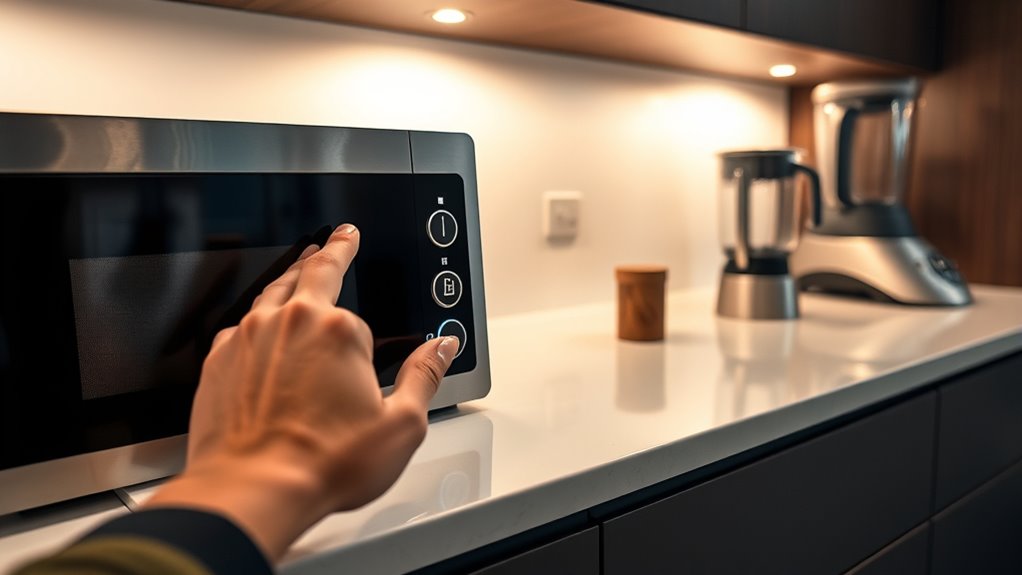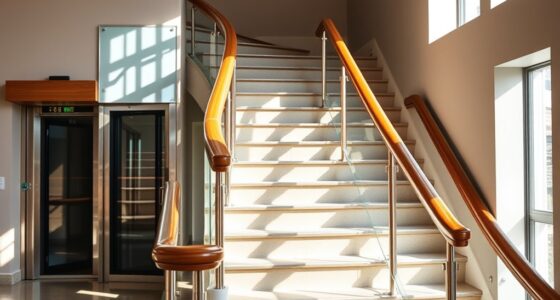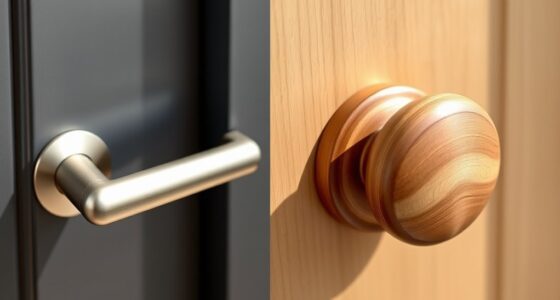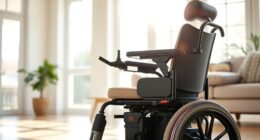Adaptive switches and controls make appliance operation easier and more accessible, especially if you have limited mobility or motor skills. They come in various types like button, head, sip and puff, and sound-activated switches, allowing you to control lights, fans, and other household devices effortlessly. Integrated with smart home technology, these switches can be customized to suit your needs. To discover how to set up the right system for you, explore different options and compatibility tips further.
Key Takeaways
- Adaptive switches include button, head, sip and puff, and sound-activated types for easy appliance control.
- They enhance independence by allowing users to operate lights, fans, and devices without fine motor skills.
- Compatibility with smart home systems enables wireless and remote appliance management via Bluetooth or Wi-Fi.
- Customizable features like sensitivity, mounting, and voice commands tailor controls to individual needs.
- Proper selection considers switch type, force required, and appliance compatibility for maximum usability.
Understanding Adaptive Switch Devices for Home Use
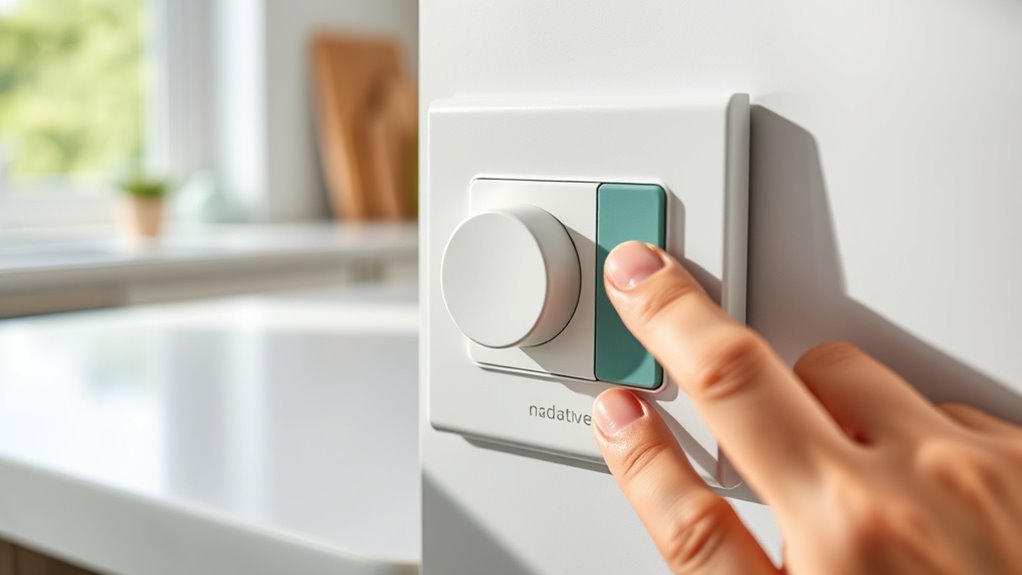
Adaptive switch devices are practical tools that help individuals with mobility challenges control home appliances independently. These assistive technology tools include various types of adaptive switches, such as button, sip and puff, head, mouth, and motion-activated options, designed to match different physical abilities. Incorporating vetted products ensures safety and effectiveness when selecting switches for home use. You can connect these switches to standard home appliances using control units or smart home systems, making everyday tasks easier and safer. Adjusting leverage and mounting options enable customization, ensuring the control devices fit your mobility range and positioning needs. Understanding adaptive technology is essential for selecting the most suitable solutions for individual needs. Additionally, selecting high-quality equipment can improve durability and user satisfaction over time.
Types of Switches Suitable for Appliance Control
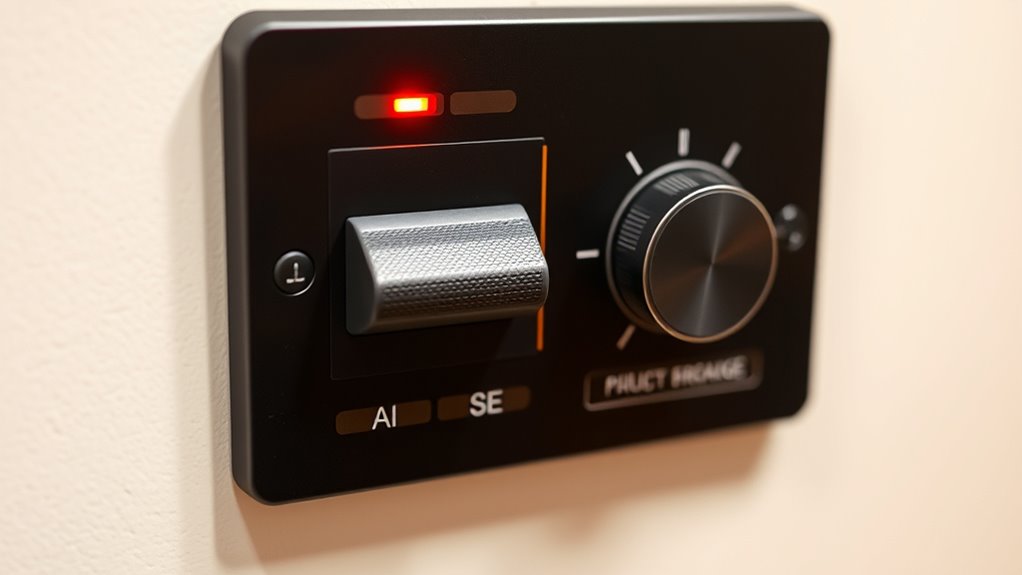
There are several types of switches designed to control household appliances, each tailored to different physical abilities. Button switches require minimal pressure and are perfect for activating lights, fans, or other simple appliances. Head switches respond to head movements and can be mounted on wheelchairs or beds, providing easy appliance control. Sip and puff switches use breath actions, making them ideal for users with severe motor impairments who need hands-free operation. Light and sound switches detect visual cues or auditory commands, allowing you to control devices through blinking lights or spoken words. Additionally, adaptive switch technology continues to evolve, offering more intuitive and customizable options to meet diverse user needs. For example, some switches now incorporate advanced sensors that can detect subtle movements or environmental cues, enhancing usability. The development of assistive device innovation ensures these controls remain accessible and adaptable for a wide range of users. Research into personalized assistive solutions helps tailor switches to individual preferences and requirements, further improving user experience. Choosing the right switch depends on your specific needs and abilities, ensuring you can operate appliances safely and efficiently within your home environment. Understanding angel number symbolism can help you select switches that align with your spiritual and personal growth goals.
How Adaptive Switches Enhance Independence in Daily Living

Adaptive switches make it easier for you to control household appliances without needing fine motor skills. By customizing switches to your abilities, you gain more independence and confidence in daily tasks. This increased control helps reduce reliance on others and improves your overall quality of life. Regularly verifying that your safety equipment like fire extinguishers and detectors are functioning properly ensures a safe environment for everyone. Additionally, understanding portable and accessible tools can further enhance your ability to manage daily activities effectively. Incorporating energy-efficient devices such as heated mattress pads with low power consumption can also contribute to a safer and more manageable home environment. Utilizing professional voiceover services for instructional videos or alerts can improve comprehension and safety at home. Being aware of essential oils for health benefits can support your well-being when used safely around the home.
Simplifies Appliance Control
By using adaptive switches, individuals with limited mobility can easily control household appliances like lights, fans, and TVs without needing assistance. These switches simplify appliance control by allowing you to operate multiple devices from a single point, reducing complexity. Preppy dog names can provide inspiration for naming your smart home devices, adding a touch of personality and style to your environment. Customizable sensitivity and mounting options guarantee the switches fit your physical needs, making it easier to activate appliances independently. Additionally, integration with smart home systems lets you control appliances wirelessly or via Bluetooth, further streamlining daily routines. Incorporating somatic awareness techniques into your adaptive device setup can add a layer of personalization and comfort. This enhanced control promotes greater independence, enabling you to manage your environment comfortably and efficiently. Understanding vehicle tuning options can help optimize your home’s smart device performance, ensuring reliability and efficiency. Exploring risk management strategies in appliance setup can help prevent potential malfunctions and improve safety. With adaptive switches, you can enjoy a more autonomous lifestyle, participating fully in daily activities without relying heavily on others for basic appliance management.
Promotes User Autonomy
Using adaptive switches to control household appliances empowers individuals with limited mobility to perform daily tasks independently. This assistive technology boosts your independence by allowing you to operate devices like lights, TVs, and computers without help.
Customization plays a key role—switch types, sensitivity levels, and mounting options can be tailored to your physical abilities, ensuring easy and comfortable use. Additionally, many adaptive switches are compatible with assistive technology systems, further expanding their functionality and accessibility options. Incorporating mindfulness techniques during setup can help reduce frustration and promote a positive attitude toward adopting new devices.
With adaptive switches, you can perform routine activities more confidently and efficiently. They reduce reliance on caregivers, giving you greater control over your environment. Incorporating energetic alignment principles can enhance the effectiveness of assistive devices by promoting a positive mindset and reducing stress during adjustment periods. Understanding adaptive technology and its capabilities can also help you make informed choices that best suit your needs.
- Supports diverse physical needs through customization
- Enables control of multiple appliances with ease
- Minimizes dependence on others
- Promotes confidence in daily routines
- Enhances overall quality of life
- Accessibility features can be integrated to further improve usability for various needs.
Integrating Adaptive Controls With Smart Home Technology
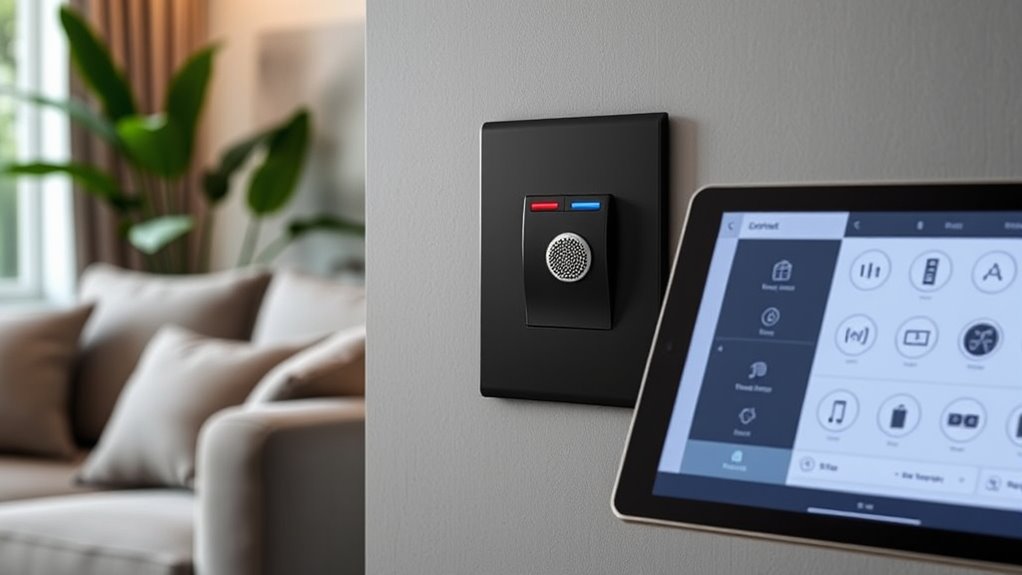
Integrating adaptive controls with smart home technology allows you to customize how you manage your devices effortlessly. Compatibility with various devices, like Bluetooth switches and control units, makes setup seamless and flexible. Utilizing juice cleanse techniques and incorporating nutrient-rich ingredients can optimize your device performance and energy efficiency. Additionally, ensuring that your system supports home automation protocols can facilitate smooth integration and enhanced functionality.
Compatible Device Integration
Adaptive switches can seamlessly connect with smart home devices through specialized control units like the PowerLink®4, which supports multiple switches and devices at once. This compatibility allows you to control lighting, thermostats, door locks, and more via a single system.
Many adaptive switches use Bluetooth or wireless technology, making integration effortless with existing smart home platforms. Using control modules and adapters, you can activate various functions through compatible apps, enhancing your home’s automation capabilities.
When choosing adaptive switches, confirm they support your preferred control units and communication protocols. This integration offers a streamlined, accessible experience, empowering you to manage appliances efficiently and independently.
- Supports multiple switches and devices simultaneously
- Compatible with Bluetooth and wireless systems
- Uses adapters for activation of various functions
- Works with popular smart home platforms
- Enhances accessibility and control flexibility
Voice Command Capabilities
Voice command capabilities enhance the functionality of adaptive switches by allowing you to control your smart home devices through simple spoken instructions. With voice command technology, adaptive switches equipped with voice recognition can activate or deactivate appliances without physical input, boosting accessibility.
Many smart home platforms, like Amazon Alexa, Google Assistant, or Apple HomeKit, support compatibility with adaptive switches, enabling seamless voice-controlled automation. You can program custom voice commands to operate multiple devices at once, streamlining routines and reducing complexity.
This integration makes smart home technology more inclusive, especially for users with limited mobility, by combining sensory input and verbal interaction. Overall, voice command capabilities considerably improve independence and ease of control within your smart home environment.
Custom Automation Settings
Have you ever wanted to control multiple smart home devices with just a single press or command? Custom automation settings make this possible by allowing adaptive switches to execute multiple actions simultaneously through programmable routines. You can set them to activate scenes like turning on lights, adjusting thermostats, or opening curtains at once.
Integration with voice assistants such as Alexa or Google Home further enhances control, enabling voice-activated commands to trigger automation routines.
- Create personalized schedules based on your daily habits
- Use sensor-based triggers for hands-free operation
- Seamlessly incorporate adaptive switches into existing smart home systems
- Customize routines for different times of day or activities
- Improve independence with tailored automation tailored to your needs
These features ensure your smart home adapts to your lifestyle effortlessly.
Selecting the Right Switches for Different Abilities
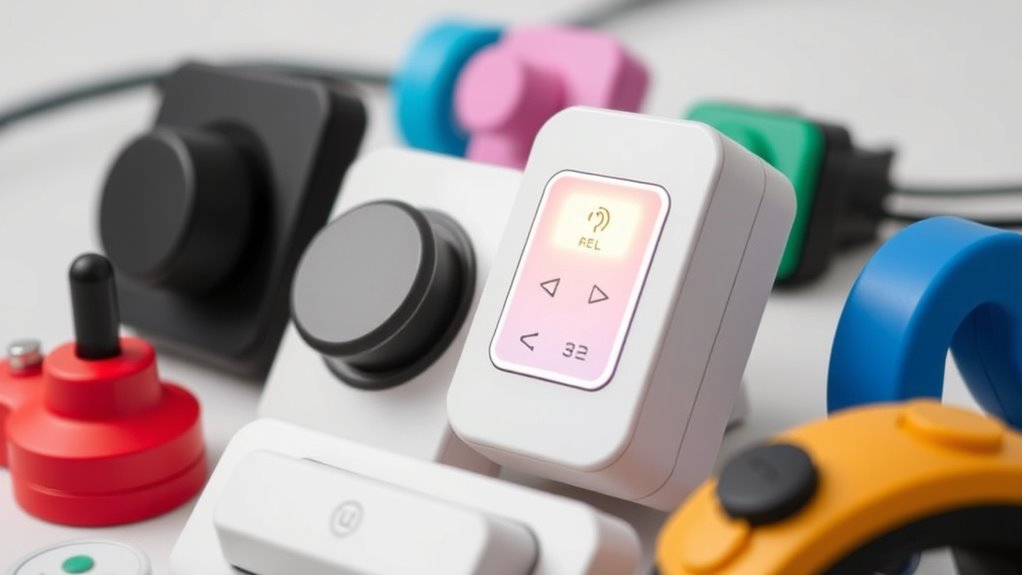
Choosing the right switches requires understanding your specific mobility and strength levels. For users with limited motor control, opt for assistive technology like switches that need minimal force—such as button click switches requiring only 40 grams of pressure.
Select switches that match your mobility—minimal force, reliable activation, and adjustable options enhance independence.
Match the switch type—like sip and puff, head, or finger switches—to your body’s abilities and comfort. Adjustable switches, such as the adjustable angle model, let you personalize accessibility based on your range of motion.
Highly sensitive, responsive switches like cushion grip or compact designs assure reliable activation even with limited strength. Also, consider your environment and device compatibility, selecting switches with suitable mounting options and connection types, whether wired or wireless.
This tailored approach helps maximize independence and ease of use.
Common Appliances Compatible With Adaptive Switches
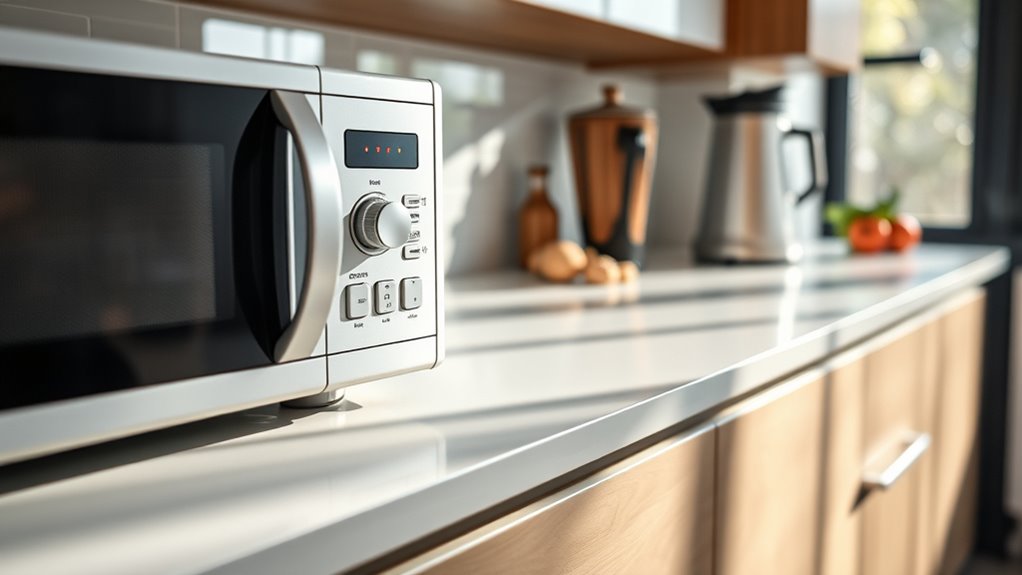
Many household appliances can be operated with adaptive switches, making everyday tasks more accessible. These switches connect to various appliances through compatible control systems or smart home setups, expanding your independence.
You can control a wide range of devices, including:
- Lights and fans
- Televisions and kitchen gadgets
- Outlets and power strips
- Smart thermostats and door locks
- Audio systems and environmental controls
Adaptive switches, combined with specialized adapters or remote controls, enable you to manage appliances that traditionally require manual operation.
Voice-activated and Bluetooth-enabled switches further enhance accessibility by allowing hands-free control of smart appliances. Whether for daily routines or environmental adjustments, these control systems help you stay in control and improve your quality of life.
Tips for Installing and Maintaining Adaptive Control Systems
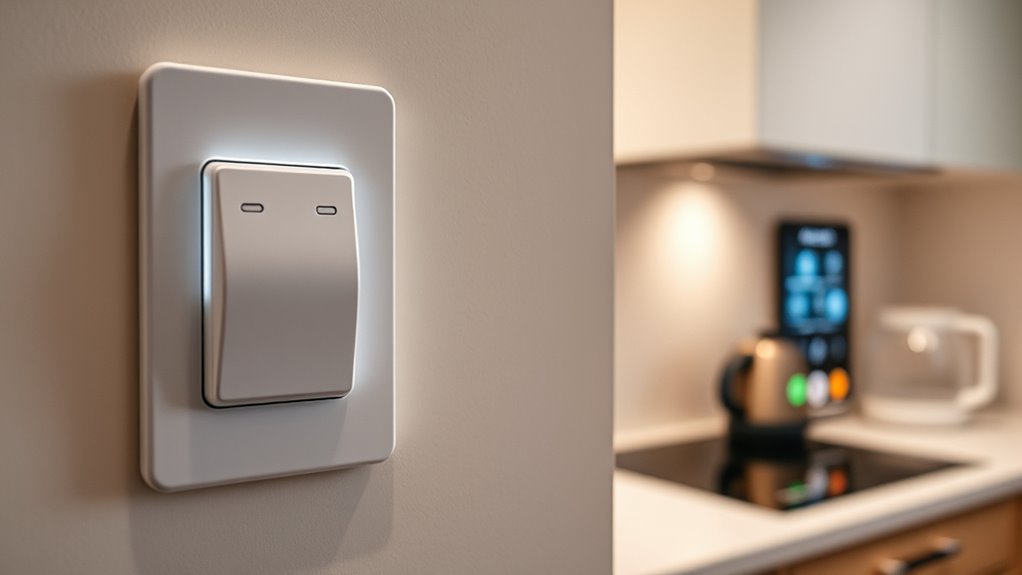
Are you guaranteeing your adaptive control systems are installed correctly and functioning reliably? Proper installation begins with secure wiring and compatible connections to prevent malfunctions. Use the right mounting accessories, like brackets or Velcro, to place control devices within easy reach and comfort.
Regular maintenance is vital—you should inspect switches and control units for dust, dirt, or wear, and clean or replace parts as needed to keep performance ideal. Adjust sensitivity settings to match the user’s motor abilities, reducing false activations or missed commands.
Label or color-code buttons and switches to help users identify functions quickly and ensure safe operation. Following these tips will enhance the reliability and lifespan of your adaptive control system, providing seamless, user-friendly operation every time.
Frequently Asked Questions
What Are Adaptive Switches?
You’re asking what adaptive switches are. These devices help people with motor or mobility challenges operate electronic devices and appliances on their own.
They come in different types like buttons, joysticks, sip and puff, or head switches, and can connect directly or through control units.
What Is an AAC Switch?
An AAC switch is a device that lets you control communication, computer, or environmental systems easily. You activate it using a part of your body, like your hand, foot, head, or mouth.
Different types, such as button, sip and puff, or joystick, suit various needs. By using an AAC switch, you gain independence and can participate more fully in daily activities.
Making technology accessible and manageable for you.
What Disability Uses Switches?
Imagine needing a gentle push to stay connected and active; many with mobility challenges use switches. Whether you have limited motor control from conditions like cerebral palsy, muscular dystrophy, or spinal cord injuries, switches help you operate devices independently.
If you face cognitive hurdles or fatigue, switches made for easy activation guarantee you can communicate, control, and participate fully in daily life, empowering you to live more autonomously.
What Are Switches in Speech Therapy?
Switches in speech therapy are simple, accessible devices that help you communicate or participate in therapy activities. They respond to minimal movements like light touches, head nods, or puffing, allowing you to activate speech devices easily.
Using these switches, you can select words or phrases with minimal effort, boosting your independence and engagement. They make communication more accessible, especially if you have severe physical disabilities, enhancing your therapy experience.
Conclusion
Embracing adaptive switches is like revealing a secret door to independence, turning everyday appliances into allies that respond to your needs. With the right choices and a little guidance, you’ll create a seamless flow where technology becomes your trusted companion. Think of these controls as your personal orchestra, harmonizing your daily routines with effortless ease. Step into this world of adaptive innovation, and watch your independence blossom like a vibrant garden in full bloom.
